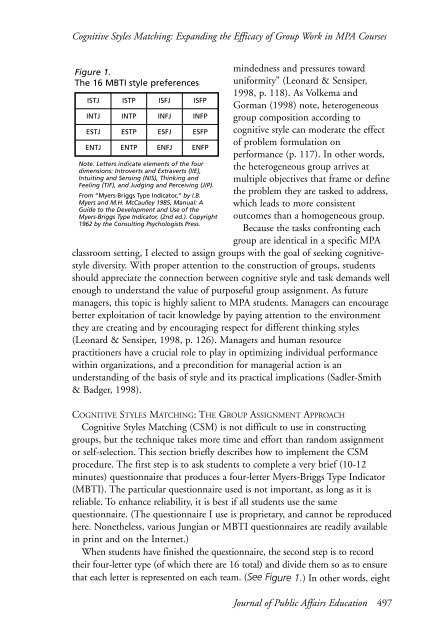JOURNAL OF PUBLIC AFFAIRS EDUCATION - National ...
JOURNAL OF PUBLIC AFFAIRS EDUCATION - National ...
JOURNAL OF PUBLIC AFFAIRS EDUCATION - National ...
You also want an ePaper? Increase the reach of your titles
YUMPU automatically turns print PDFs into web optimized ePapers that Google loves.
Cognitive Styles Matching: Expanding the Efficacy of Group Work in MPA Courses<br />
Figure 1.<br />
The 16 MBTI style preferences<br />
ISTJ ISTP ISFJ ISFP<br />
INTJ INTP INFJ INFP<br />
ESTJ ESTP ESFJ ESFP<br />
ENTJ ENTP ENFJ ENFP<br />
Note. Letters indicate elements of the four<br />
dimensions: Introverts and Extraverts (I/E),<br />
Intuiting and Sensing (N/S), Thinking and<br />
Feeling (T/F), and Judging and Perceiving (J/P).<br />
From “Myers-Briggs Type Indicator,” by I.B.<br />
Myers and M.H. McCaulley 1985, Manual: A<br />
Guide to the Development and Use of the<br />
Myers-Briggs Type Indicator, (2nd ed.). Copyright<br />
1962 by the Consulting Psychologists Press.<br />
mindedness and pressures toward<br />
uniformity” (Leonard & Sensiper,<br />
1998, p. 118). As Volkema and<br />
Gorman (1998) note, heterogeneous<br />
group composition according to<br />
cognitive style can moderate the effect<br />
of problem formulation on<br />
performance (p. 117). In other words,<br />
the heterogeneous group arrives at<br />
multiple objectives that frame or define<br />
the problem they are tasked to address,<br />
which leads to more consistent<br />
outcomes than a homogeneous group.<br />
Because the tasks confronting each<br />
group are identical in a specific MPA<br />
classroom setting, I elected to assign groups with the goal of seeking cognitivestyle<br />
diversity. With proper attention to the construction of groups, students<br />
should appreciate the connection between cognitive style and task demands well<br />
enough to understand the value of purposeful group assignment. As future<br />
managers, this topic is highly salient to MPA students. Managers can encourage<br />
better exploitation of tacit knowledge by paying attention to the environment<br />
they are creating and by encouraging respect for different thinking styles<br />
(Leonard & Sensiper, 1998, p. 126). Managers and human resource<br />
practitioners have a crucial role to play in optimizing individual performance<br />
within organizations, and a precondition for managerial action is an<br />
understanding of the basis of style and its practical implications (Sadler-Smith<br />
& Badger, 1998).<br />
COGNITIVE STYLES MATCHING: THE GROUP ASSIGNMENT APPROACH<br />
Cognitive Styles Matching (CSM) is not difficult to use in constructing<br />
groups, but the technique takes more time and effort than random assignment<br />
or self-selection. This section briefly describes how to implement the CSM<br />
procedure. The first step is to ask students to complete a very brief (10-12<br />
minutes) questionnaire that produces a four-letter Myers-Briggs Type Indicator<br />
(MBTI). The particular questionnaire used is not important, as long as it is<br />
reliable. To enhance reliability, it is best if all students use the same<br />
questionnaire. (The questionnaire I use is proprietary, and cannot be reproduced<br />
here. Nonetheless, various Jungian or MBTI questionnaires are readily available<br />
in print and on the Internet.)<br />
When students have finished the questionnaire, the second step is to record<br />
their four-letter type (of which there are 16 total) and divide them so as to ensure<br />
that each letter is represented on each team. (See Figure 1.) In other words, eight<br />
Journal of Public Affairs Education 497

















